The Rescuers
8.2 /10 1 Votes
83% Rotten Tomatoes Duration Language English | 6.9/10 IMDb 4.7/5 Amazon Genre Animation, Adventure, Family Country United States | |||||||||||||||||||||||||||||||||
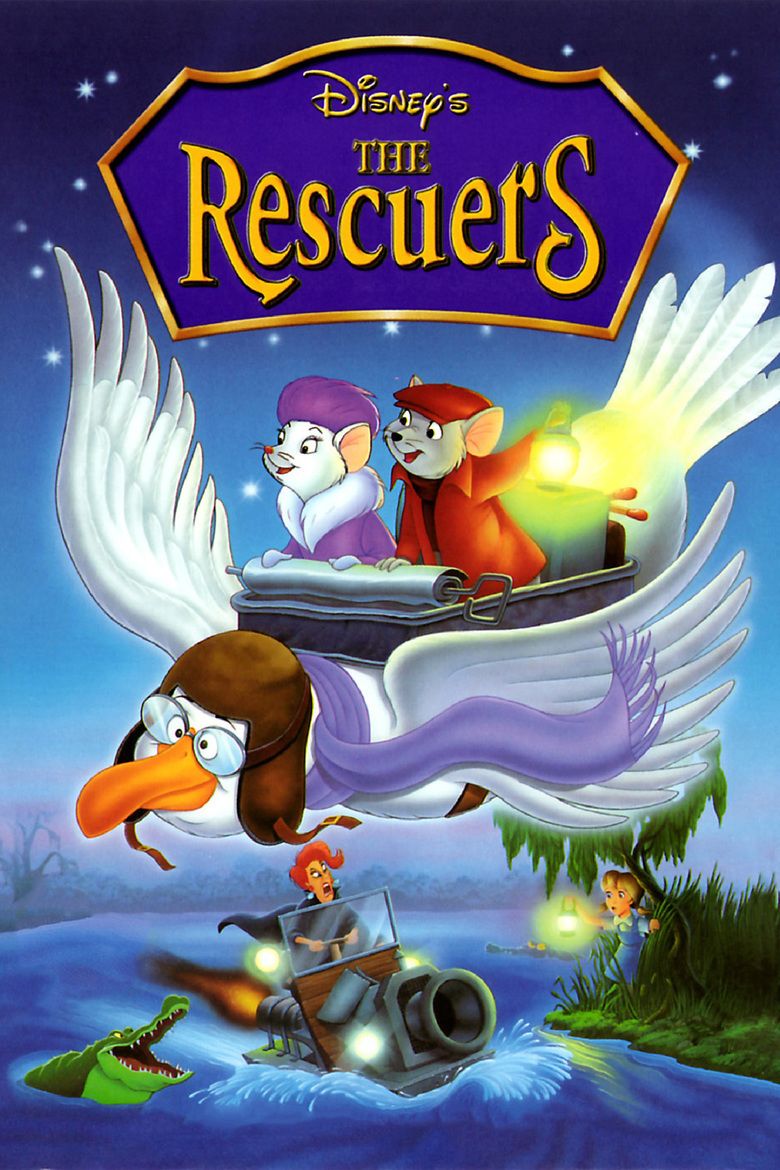 | ||||||||||||||||||||||||||||||||||
Director Wolfgang ReithermanJohn LounsberyArt Stevens Release date June 22, 1977 (1977-06-22) Writer Margery Sharp (suggested by "The Rescuers" and "Miss Bianca" by), Larry Clemmons (story), Ken Anderson (story), Frank Thomas (story), Vance Gerry (story), David Michener (story), Ted Berman (story), Fred Lucky (story), Burny Mattinson (story), Dick Sebast (story) Initial release June 19, 1977 (Washington, D.C.) Film series Walt Disney Animated Classics Featured songs Rescue Aid Society, Someones Waiting for You Cast (Bernard (voice)), (Miss Bianca (voice)), (Madame Medusa (voice)), (Mr. Snoops (voice)), (Ellie Mae (voice)), (Luke (voice)) Similar movies Mad Max: Fury Road , The Rescuers Down Under , Cinderella , Dumbo , Fargo , Transporter 2 Tagline Two tiny agents vs. the world's wickedest woman in a dazzling animated adventure! | ||||||||||||||||||||||||||||||||||
The Rescuers is a 1977 American animated comedy-drama adventure film produced by Walt Disney Productions and first released on June 22, 1977, by Buena Vista Distribution. The 23rd Disney animated feature film, the film is about the Rescue Aid Society, an international mouse organization headquartered in New York City and shadowing the United Nations, dedicated to helping abduction victims around the world at large. Two of these mice, jittery janitor Bernard (Bob Newhart) and his co-agent, the elegant Miss Bianca (Eva Gabor), set out to rescue Penny (Michelle Stacy), an orphan girl being held prisoner in the Devil's Bayou by treasure huntress Madame Medusa (Geraldine Page).
Contents
- Plot
- Cast
- Production
- Animation
- Music
- Track list
- Release
- Marketing
- Home media
- Controversy
- Box office
- Critical reaction
- Accolades
- Sequel
- References
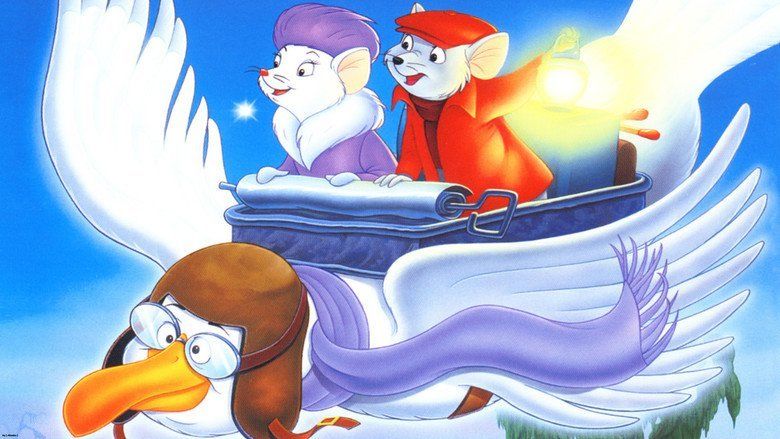
The film is based on a series of books by Margery Sharp, most notably The Rescuers and Miss Bianca. Due to the film's success, a sequel entitled The Rescuers Down Under was released in 1990, which made this film the first Disney animated film to have a sequel.

Plot
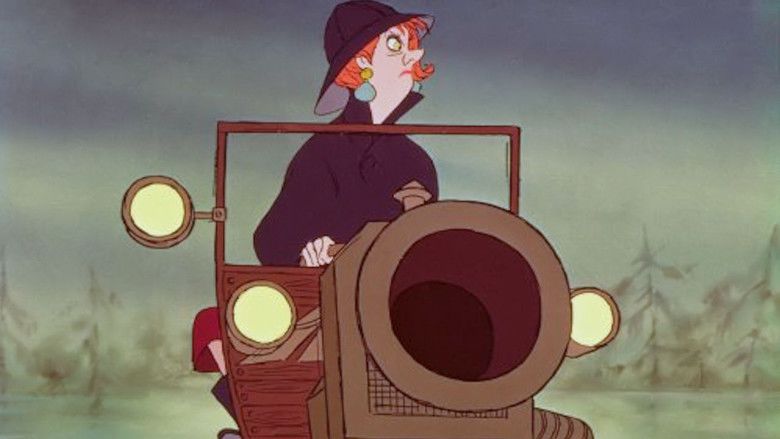
In an abandoned river boat in Devil's Bayou, a young orphan named Penny drops a message in a bottle, containing a plea for help into the river. The bottle washes up in New York City, where it is recovered by the Rescue Aid Society, an international mouse organization inside the United Nations. The Hungarian representative, Miss Bianca, volunteers to accept the case and chooses Bernard, a stammering janitor, as her co-agent. The two visit Morningside Orphanage, where Penny lived, and meet an old cat named Rufus. He tells them about a woman named Madame Medusa who once tried to lure Penny into her car and may have succeeded in abducting Penny this time.
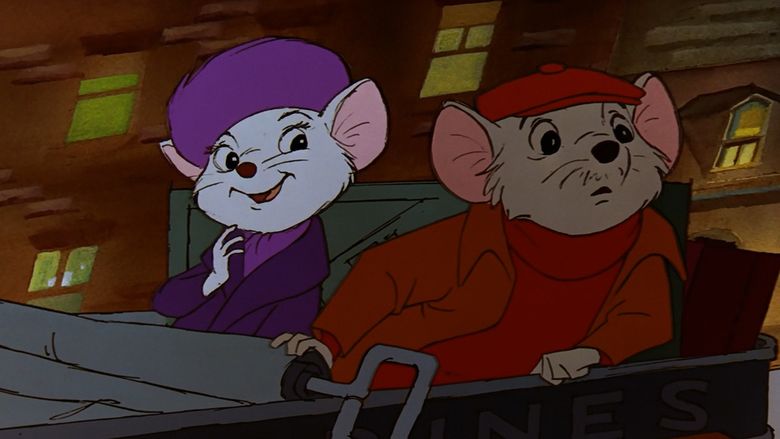
The mice travel to Medusa's pawn shop, where they discover that she and her partner, Mr. Snoops, are on a quest to find the world's largest diamond, the Devil's Eye. They also discover that Medusa and Mr. Snoops are at the Devil's Bayou with Penny, whom they have indeed kidnapped, and whom they guard with two trained crocodiles called Brutus and Nero. With the help of an albatross named Orville, and a dragonfly named Evinrude, the mice follow Medusa to the bayou. There, they learn that Penny was captured to enter a hole that leads down into the pirates' cave where the Devil's Eye is located.
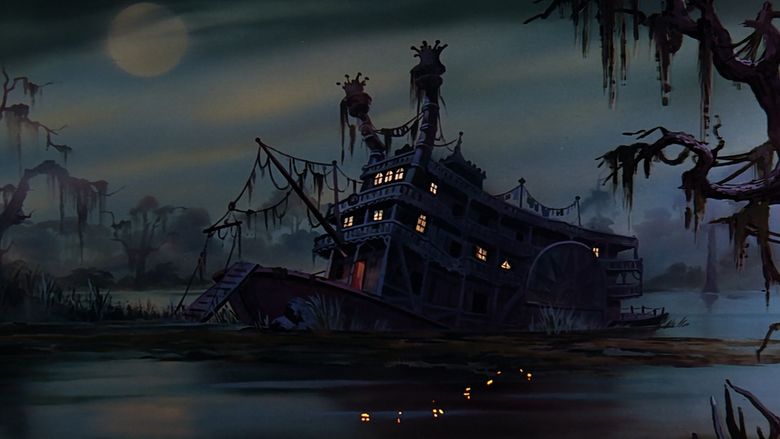
Bernard and Miss Bianca find Penny and devise a plan of escape and send Evinrude to alert the local animals, who loathe Medusa, but Evinrude is delayed when he is forced to take shelter from a flock of bats. The following morning, Medusa and Mr. Snoops send Penny down into a pirate's cave to find the gem, with Miss Bianca and Bernard hiding in her skirt pocket. The three soon find the Devil's Eye within a pirate skull; as Penny pries the mouth open with a sword, the mice push it out from within, but soon the oceanic tide rises and floods the cave. Miss Bianca, Penny, and Bernard barely manage to retrieve the diamond and escape.

Medusa plans to keep the diamond for herself, hiding it in Penny's teddy bear while holding Penny and Snoops at gunpoint. When she trips over a cable set as a trap by Bernard and Bianca, Medusa loses the bear to Penny, who runs away with it. The local animals arrive at the riverboat and aid Bernard and Bianca by trapping Brutus and Nero, then setting off Snoops's fireworks to create more chaos. Meanwhile, Penny and the mice commandeer Medusa's swamp-mobile, a makeshift airboat. Medusa unsuccessfully pursues them, using Brutus and Nero as water-skis, and is left clinging to the boat's smoke stacks as the irritated Brutus and Nero circle below while Snoops escapes.
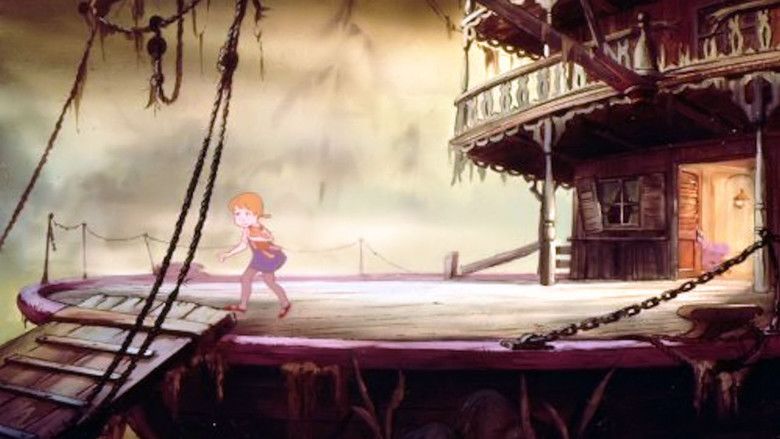
Back in New York, the Rescue Aid Society watch a news report of how Penny found the Devil’s Eye, which has been given to the Smithsonian Institution, and how she has been adopted. The meeting is interrupted when Evinrude arrives with a call for help, sending Bernard and Bianca on a new adventure.
Cast
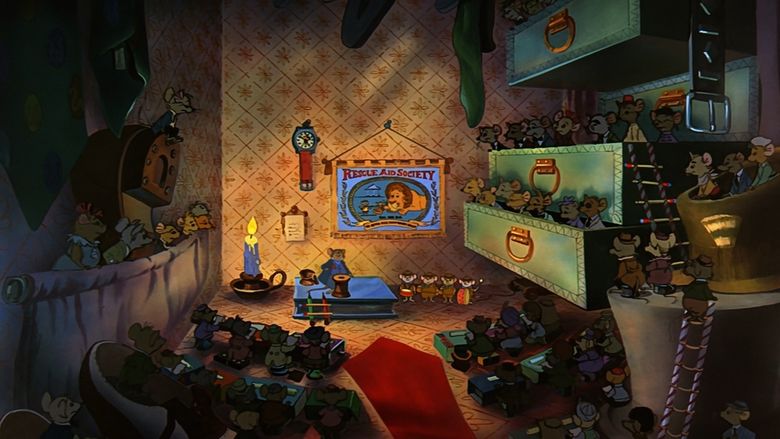
Production
In 1962, the film began development with its initial treatment developed from the first book centering on a poet held captive by a totalitarian government in the Siberia-like stronghold. However, as the story grew overtly involved with international intrigue, Walt Disney shelved the project as he was unhappy with the political overtones. The project was revived in the early 1970s as a project for the young animators, led by Don Bluth, as the studio would alternate between full-scale "A pictures" and smaller, scaled-back "B pictures" with simpler animation. The animators had selected the most recent book, Miss Bianca in the Antarctic, with its story focusing on a captured polar bear forced into performing in shows causing the unsatisfied bear to place a bottle that would reach the mice. Jazz singer Louis Prima was to voice the character named Louis the Bear, and this version was to feature six songs sung by Prima written by Floyd Huddleston. However, in 1975, following headaches and episodes of memory loss, Prima discovered he had a stem brain tumor, and the project was scrapped.
Meanwhile, the "A" crew had finished work on Robin Hood, and was set to begin production on an adaptation of Paul Gallico's book titled Scruffy under the direction of Ken Anderson. Its story concerned the monkeys of Gibraltar under World War II, which also involved Nazis. When the time had come to greenlight one of the two projects, the studio leaders eventually decided to go for The Rescuers. When Scruffy was shelved, the veteran team turned the project into a more traditional, full-scale production ultimately dropping the Arctic setting of the story with veteran Disney writer Fred Lucky stating, "It was too stark a background for the animators." Cruella de Vil, the villainess from One Hundred and One Dalmatians, was originally considered to be the main antagonist of the film, but Disney animator Ollie Johnston stated it felt wrong to attempt a sequel and the idea was dropped. Instead, she was replaced by a retouched version of the Diamond Duchess in Miss Bianca. The motive to steal a diamond originated in Margery Sharp's 1959 novel, Miss Bianca. Her appearance was based on animator Milt Kahl's ex-wife, whom he did not particularly like. This was Kahl's last film for the studio, and he wanted his final character to be his best; he was so insistent on perfecting Madame Medusa that he ended up doing almost all the animation for the character himself. Penny was inspired by Patience, the orphan in the novel. For the accomplices, the filmmakers adapted the character, Mandrake, into Mr. Snoops and his appearance was caricatured from animation historian John Culhane. Culhane claims he was practically tricked into posing for various reactions, and his movements were imitated on Mr. Snoops's model sheet. However, he stated, "Becoming a Disney character was beyond my wildest dreams of glory." Brutus and Nero are based on the two bloodhounds, Tyrant and Torment in the novels.
The writers had considered developing Bernard and Bianca into married professional detectives, though they decided that leaving the characters as unmarried novices was more romantic. For the supporting characters, a pint-sized swampmobile for the mice – a leaf powered by a dragonfly – was created. As they developed the comedic potential of displaying his exhaustion through buzzing, the dragonfly grew from an incidental into a major character. Veteran sound effects artist and voice talent Jimmy MacDonald came out of retirement to provide the effects. Also, the local swamp creatures were organized into a dedicated home guard that drilled and marched incessantly. However, the writers evolved them into a volunteer group of helpful little bayou creatures. Their leader, a singing bullfrog voiced by Phil Harris, was deleted from the film. A pigeon was originally proposed to be the transportation for Bernard and Bianca, until Ollie Johnston remembered a True Life Adventures episode that showed albatrosses and their clumsy take-offs and landings, and suggested the ungainly bird instead.
Animation
Ever since One Hundred and One Dalmatians, animation for theatrical Disney animated films was done by xerography, which had been only been able to produce black outlines, but had been improved for the cel artists to use a medium-grey toner in order to create a softer-looking line. At the end of production, it marked the last joint effort by veterans Milt Kahl, Ollie Johnston, and Frank Thomas, and the first Disney film worked on by Don Bluth as an animator, instead of an assistant animator. Other animators who stepped up during production were Glen Keane, Ron Clements, and Andy Gaskill, who would all play an important role in the Disney Renaissance.
Music
The songs were written by Sammy Fain, Carol Connors, and Ayn Robbins, and performed by Shelby Flint. For the first time since Bambi, all the most significant songs were sung as part of a narrative, as opposed to by the film's characters as in most Disney animated films.
Track list
Side A
01. "The Journey" – Shelby Flint
02. "Rescue Aid Society" – Bernard Fox, Bob Newhart, and Robie Lester
03. "Tomorrow Is Another Day" – Shelby Flint
Side B
04. "Someone's Waiting For You" – Shelby Flint
05. "Tomorrow Is Another Day (Reprise)" – Shelby Flint
Release
The Rescuers was re-released to theaters on December 16, 1983 along with a new Mickey Mouse featurette, Mickey's Christmas Carol, Mickey's first theatrical appearance after a 30-year absence. In anticipation of its upcoming theatrically released sequel in 1990, The Rescuers Down Under, The Rescuers saw another successful theatrical run on March 17, 1989.
Marketing
To tie in with the film's 25th Anniversary, The Rescuers debuted in the Walt Disney Classics Collection line in 2002, with three different figures featuring three of the film's biggest stars, as well as the opening title scroll. The three figures were sculpted by Dusty Horner and they were: Brave Bianca, featuring Miss Bianca the heroine and priced at $75, Bold Bernard, featuring hero Bernard, priced also at $75 and Evinrude Base, featuring Evinrude the dragonfly and priced at $85. The title scroll featuring the film's name, The Rescuers and from the opening song sequence "The Journey," was priced at $30. All figures were retired in March 2005, except for the opening title scroll which was suspended in December 2012.
The Rescuers was the inspiration for another Walt Disney Classics Collection figure in 2003. Ken Melton was the sculptor of Teddy Goes With Me, My Dear, a limited edition, 8-inch sculpture featuring the evil Madame Medusa, the orphan girl Penny, her teddy bear "Teddy" and the Devil's Eye diamond. 1,977 of these sculptures were made, in reference to the film's release year, 1977. The sculpture was priced at $299 and instantly declared retired in 2003.
In November 2008, a sixth sculpture inspired by the film was released. Made with pewter and resin, Cleared For Take Off introduced the character of Orville into the collection and featured Bernard and Bianca a second time. The piece, inspired by Orville's take-off scene in the film, was sculpted by Ruben Procopio.
Home media
The Rescuers premiered on VHS and Laserdisc on September 18, 1992 as part of the Walt Disney Classics series. It was re-released on VHS as part of the Walt Disney Masterpiece Collection on January 5, 1999, but was recalled three days later and reissued on March 23, 1999 (see "Controversy").
The Rescuers was released on DVD on May 20, 2003, as a standard edition, which was discontinued in November 2011.
On August 21, 2012, a 35th anniversary edition of The Rescuers was released on Blu-ray alongside its sequel in a "2-Movie Collection".
Controversy
On January 8, 1999, three days after the film's second release on home video, The Walt Disney Company announced a recall of about 3.4 million copies of the videotapes because there was an objectionable image in one of the film's background cels.
The image in question is a blurry image of a topless woman that appears in two out of the film's more than 110,000 frames. The image appears twice in non-consecutive frames during the scene in which Miss Bianca and Bernard are flying on Orville's back through New York City. The two images could not be seen in ordinary viewing because the film runs too fast — at 30 frames per second on video.
On January 10, 1999, two days after the recall was announced, the London press site The Independent reported:
A Disney spokeswoman said that the images in The Rescuers were placed in the film during production, but she declined to say what they were or who placed them... The company said the aim of the recall was to keep its promise to families that they can trust and rely on the Disney brand to provide the best in family entertainment.
The Rescuers video was reissued March 23, 1999, with the offending image edited out.
Box office
The Rescuers was successful upon its original theatrical release earning $48 million at the box office and becoming Disney's most successful film to that date. During its initial release in France, it out-grossed Star Wars and became the highest-grossing film in West Germany at the time. The distributor rentals accumulated $19 million while its international rentals grossed $41 million. The film broke a record for the largest financial amount made for an animated film on opening weekend, a record it kept until 1986, when An American Tail broke the record. The Rescuers was Disney's first significant success since The Jungle Book (1967) and the last until The Little Mermaid (1989). The Rescuers was re-issued in theaters in 1983 and 1989. The Rescuers has had a lifetime gross of $71.2 million across its original release and several reissues.
Critical reaction
The Rescuers was said to be Disney's greatest film since Mary Poppins (1964), and seemed to signal a new golden age for Disney animation. The review aggregator website Rotten Tomatoes reported that the film received a 83% approval rating with an average rating of 6.6/10 based on 26 reviews. The website's consensus states that "Featuring superlative animation, off-kilter characters, and affectionate voice work by Bob Newhart and Eva Gabor, The Rescuers represents a bright spot in Disney's post-golden age." TV Guide gave the film three stars out of five, saying that "Four years in the making, costing nearly $8 million, THE RESCUERS is a beautifully animated film that showed Disney still knew a lot about making quality children's fare even as their track record was weakening. [...] Comic relief is provided by a bird named Orville, who transports the mice as they search for the girl. The voices are all well suited to the characters, and the film is a delight for children as well as adults who appreciate good animation and brisk storytelling." Ellen MacKay of Common Sense Media gave the film four out of five stars, writing, "Great adventure, but too dark for preschoolers".
In his book, The Disney Films, film historian Leonard Maltin refers to The Rescuers as "a breath of fresh air for everyone who had been concerned about the future of animation at Walt Disney's," praises its "humor and imagination and [it is] expertly woven into a solid story structure [...] with a delightful cast of characters." Finally, he declares the film "the most satisfying animated feature to come from the studio since 101 Dalmatians." He also briefly mentions the ease with which the film surpassed other animated films of its time.
Jack Shaheen, in his study of Hollywood portrayals and stereotypes of Arabs, noted the inclusion of delegates from Arab countries in the Rescue Aid Society.
Accolades
The Rescuers was nominated in 1978 for an Academy Award for the song "Someone's Waiting for You" at the 50th Academy Awards. The song lost to "You Light Up My Life" from the film of the same name.
The film is recognized by American Film Institute in these lists:
Sequel
The Rescuers was the first Disney animated film to have a sequel. After three successful theatrical releases of the original film, The Rescuers Down Under was released theatrically on November 16, 1990.
The Rescuers Down Under takes place in the Australian Outback, and involves Bernard and Bianca trying to rescue a boy named Cody and a giant golden eagle called Marahute from a greedy poacher named Percival C. McLeach. Both Bob Newhart and Eva Gabor reprised their lead roles. Jim Jordan, the voice of Orville, had since died, so a new albatross character, Wilbur, was voiced by John Candy.
References
The Rescuers WikipediaThe Rescuers IMDbThe Rescuers Rotten TomatoesThe Rescuers Amazon.comThe Rescuers themoviedb.org
